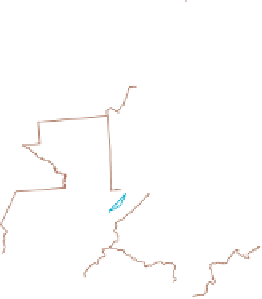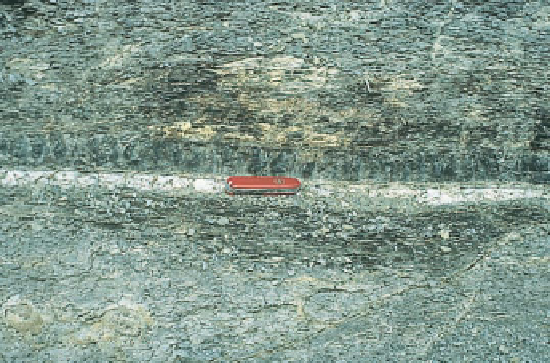Geology Reference
In-Depth Information
◗
Figure 22.33
Mesozoic Extinctions
*20 mm=320 kilometers
Belize
Mexico
Guatemala
Honduras
El Salvador
0
20
0 km
Nic.
a
Closeup view of the iridium-rich Cretaceous-Paleogene boundary clay
in the Raton Basin, New Mexico.
b
Proposed meteorite impact crater centered on
Chicxulub on the Yucatán Peninsula of Mexico.
Now some geologists point to a probable impact site cen-
tered on the town of Chicxulub on the Yucatán Peninsula of
Mexico (Figure 22.33b). The 180-km-diameter structure lies
beneath layers of sedimentary rock and appears to be the right
age. Evidence that supports the conclusion that the Chicxu-
lub structure is an impact crater includes shocked quartz, the
deposits of huge waves, and tektites—small pieces of rock
melted during the impact and hurled into the atmosphere.
Even if a meteorite did hit Earth, did it lead to these ex-
tinctions? If so, both terrestrial and marine extinctions must
have occurred at the same time. To date, strict time equivalence
between terrestrial and marine extinctions has not been demon-
strated. The selective nature of the extinctions is also a problem.
In the terrestrial realm, large animals were the most affected,
but not all dinosaurs were large, and crocodiles, close relatives
of dinosaurs, survived, although some species died out. Some
paleontologists think that dinosaurs, some marine invertebrates,
and many plants were already on the decline and headed for ex-
tinction before the end of the Cretaceous. A meteorite impact
may have simply hastened the process.
In the final analysis, Mesozoic extinctions have not
been explained to everyone's satisfaction. Most geologists
now concede that a large meteorite impact occurred, but we
also know that vast outpourings of lava were taking place in
what is now India. Perhaps these brought about detrimen-
tal atmospheric changes. Furthermore, the vast shallow seas
that covered large parts of the continents had mostly with-
drawn by the end of the Cretaceous, and the mild equable
Mesozoic climates became harsher and more seasonal by the
end of that era. Nevertheless, these extinctions were very se-
lective, and no single explanation accounts for all aspects of
this crisis in life history.
Chapter Summary
Tables 22.3 (page 632) and 22.4 (page 633) summarize many
Mesozaic geologic and biologic events
together—began separating from South America
and Africa, and India began rifting from
Gondwana.
We can summarize the breakup of Pangaea as follows:
■
3. South America and Africa began separating during
the Jurassic, and Europe and Africa began converging
during this time.
1. During the Late Triassic, North America began sepa-
rating from Africa. This was followed by the rifting of
North America from South America.
4. The fi nal stage in Pangaea's breakup occurred during
the Cenozoic, when Greenland completely separated
from Europe and North America.
2. During the Late Triassic and Jurassic periods, Ant-
arctica and Australia—which remained sutured





















































Search WWH ::

Custom Search